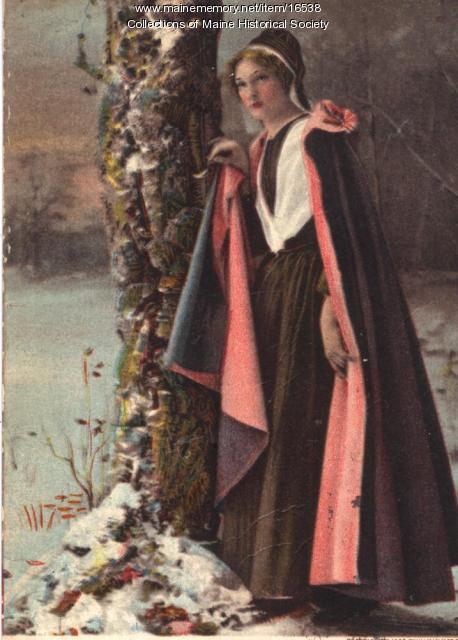Keywords: Additions
Item 105214
Maine General Hospital, Portland, ca. 1900
Contributed by: Maine Historical Society Date: circa 1900 Location: Portland Media: photographic print
Item 104191
North Twin Dam, Millinocket, 1915
Contributed by: Maine Historical Society Date: 1915-03-22 Location: Millinocket Media: Photographic print
Item 53507
Assessor's Record, 216-222 Fore Street, Portland, 1924
Owner in 1924: Chase Transfer Company Use: Shop - Addition
Item 53508
Assessor's Record, 216-222 Fore Street, Portland, 1924
Owner in 1924: Chase Transfer Company Use: Shop - Addition
Item 150980
Proposed alterations to the Atlantic House at Scarborough Beach, Scarborough, ca. 1911
Contributed by: Maine Historical Society Date: circa 1911 Location: Scarborough Client: unknown Architect: Frederick A. Tompson
Item 155337
Cumberland Club alterations and additions, Portland, 1969-1988
Contributed by: Maine Historical Society
Date: 1969–1988
Location: Portland
Client: Cumberland Club
Architect: Robert Hall Weatherill; Wadsworth, Boston & Tuttle; Wadsworth, Boston, Mercer & Weatherill
This record contains 14 images.
Exhibit
Maine Medical Center, Bramhall Campus
Maine Medical Center, founded as Maine General Hospital, has dominated Portland’s West End since its construction in 1871 on Bramhall Hill. As the medical field grew in both technological and social practice, the facility of the hospital also changed. This exhibit tracks the expansion and additions to that original building as the hospital adapted to its patients’ needs.
Exhibit
Jameson & Wotton Wharf, Friendship
Since 1897, the Jameson & Wotton Wharf in Friendship has been an important addition to the community on Muscongus Bay. The wharf, which is accessible at all tides, was a steamboat stop for many years, as well as important to the lobster business.
Site Page
Thomaston: The Town that Went to Sea - Additions and New Wing - 1824 to 1843
"Additions and New Wing - 1824 to 1843 Prison Yard Window Shades, Thomaston, Maine c 1870Thomaston Historical Society Within four years, local…"
Site Page
Farmington: Franklin County's Shiretown - "Bailey's Algebra" Textbook
"… Contributed by Farmington Historical Society Description View additional information about this item on the Maine Memory Network."
Story
A tour of unique features at St. Andre's Catholic Church
by Biddeford Cultural & Heritage Center
A tour of unique features at St. Andre's Catholic Church
Story
Aimé Muyombano, Phd - From adversity to community service
by Biddeford Cultural & Heritage Center Voices of Biddeford project
Fleeing atrocities in Africa, Professor Muyombano dedicates himself to a life of community service
Lesson Plan
Longfellow Studies: The Acadian Diaspora - Reading "Evangeline" as a Feminist and Metaphoric Text
Grade Level: 6-8, 9-12
Content Area: English Language Arts, Social Studies
Evangeline, Longfellow's heroine, has long been read as a search for Evangeline's long-lost love, Gabrielle--separated by the British in 1755 at the time of the Grand Derangement, the Acadian Diaspora. The couple comes to find each other late in life and the story ends. Or does it?
Why does Longfellow choose to tell the story of this cultural group with a woman as the protagonist who is a member of a minority culture the Acadians? Does this say something about Longfellow's ability for understanding the misfortunes of others?
Who is Evangeline searching for? Is it Gabriel, or her long-lost land of Acadia? Does the couple represent that which is lost to them, the land of their birth and rebirth? These are some of the thoughts and ideas which permeate Longfellow's text, Evangeline, beyond the tale of two lovers lost to one another. As the documentary, Evangeline's Quest (see below) states: "The Acadians, the only people to celebrate their defeat." They, as a cultural group, are found in the poem and their story is told.
Lesson Plan
Maine's Acadian Community: "Evangeline," Le Grand Dérangement, and Cultural Survival
Grade Level: 9-12
Content Area: English Language Arts, Social Studies
This lesson plan will introduce students to the history of the forced expulsion of thousands of people from Acadia, the Romantic look back at the tragedy in Henry Wadsworth Longfellow's famous epic poem Evangeline and the heroine's adoption as an Acadian cultural figure, and Maine's Acadian community today, along with their relations with Acadian New Brunswick and Nova Scotia residents and others in the Acadian Diaspora. Students will read and discuss primary documents, compare and contrast Le Grand Dérangement to other forced expulsions in Maine history and discuss the significance of cultural survival amidst hardships brought on by treaties, wars, and legislation.






















